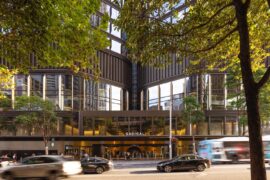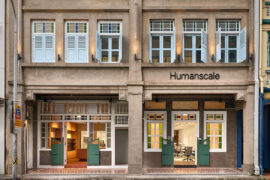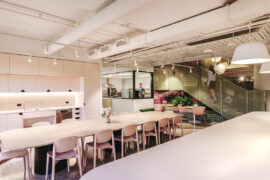Architecture, interior design and furniture work together at the new Philips APAC Center in Singapore to support collaborative exchange in a matrix-like environment. Critical to the mix are a variety of working and collaborative settings from Haworth.

December 19th, 2016
The architecture of the new Philips APAC Center in suburban Toa Payoh can really be thought of as a medium for interaction. Designed by LAUD Architects based on detailed space-planning guidelines produced by Philips’ in-house design team (Philips Design) and a strategic vision by CBRE, the building’s two wings straddle a bright atrium where opportunities for planned and impromptu meetings abound. Coffee coves, grand staircases, meeting rooms, balconies and an expansive café form part of the matrix within and around this busy central street that is lit from above during the day, and by internal streetlights at night.
The building was developed on the site of four Philips factories dating back to 1972, and accommodates the various business units under one roof for the first time. Some 900 staff members occupy the building – a figure that demands many spaces of multiple types in which people can come together, as well as multiple atmospheres in which to do so. Just as individual teams need their own working and collaboration spaces, teams need the opportunity to foster new working relationships with other business units.
Crucial to the successful integration of the staff was Philips’ ‘Workplace Innovation’ (WPI) approach. The collaborative intent that lies at the crux of the WPI approach is fostered through an activity-based work system as well as collaborative digital technologies. The appropriate range and definition of spaces is critical for the success of the activity-based system. The settings thoroughly cater to different needs and situations, ranging from open zones and collaborative areas to focus rooms, phone booths, touchdown tables, break-out areas, silent work areas and meeting rooms. And on top of the spaces provided, the Haworth furniture settings throughout the office, of course, form a solid basis on which this collaboration can be fostered.
To connect the occupants of the new building with its spaces and with each other, interior designer designphase dba worked to carefully define the zones in different areas of the floor plate with a variety of furniture. The more interactive and noisy areas near the atrium graduate to zones for quiet, contemplative work near the perimeter of each floor plate – a transition signified underfoot by a changing intensity of colour in the carpet. Colour on the furniture is also used to identify particular zones.
Haworth supplied key pieces such as the flexible Intuity workstations and meeting tables (designed as an adaptable kit of parts by bangdesign in collaboration with the Haworth design team); Planes tables (with built-in power and data connectivity); the popular EZ65 chairs (which can be readily adjusted to suit a variety of body types and ways of working); and custom-designed task pods by Haworth xFriends partner IQ Commercial. The latter create a personal private space for employees to take calls or have a private moment.
As a suite, these furniture pieces are cohesive in character yet flexible enough to allow spaces to be adapted as needed. And if you’re fortunate enough to visit the Philips APAC Centre on a typical work day, you’ll be able to judge the success of the workplace by the buzz that emanates from the collaborative spaces around the central atrium.
INDESIGN is on instagram
Follow @indesignlive
A searchable and comprehensive guide for specifying leading products and their suppliers
Keep up to date with the latest and greatest from our industry BFF's!

Rising above the new Sydney Metro Gadigal Station on Pitt Street, Investa’s Parkline Place is redefining the office property aesthetic.

For those who appreciate form as much as function, Gaggenau’s latest induction innovation delivers sculpted precision and effortless flexibility, disappearing seamlessly into the surface when not in use.

The undeniable thread connecting Herman Miller and Knoll’s design legacies across the decades now finds its profound physical embodiment at MillerKnoll’s new Design Yard Archives.

For Aidan Mawhinney, the secret ingredient to Living Edge’s success “comes down to people, product and place.” As the brand celebrates a significant 25-year milestone, it’s that commitment to authentic, sustainable design – and the people behind it all – that continues to anchor its legacy.

The workplace strategist and environmental psychologist was in Sydney earlier this year to give a talk at Haworth on the fallacies of the ‘average’ in workplace design.

The Director of Space Design for Haworth International for Asia and Europe tells us all about her global design journey.
The internet never sleeps! Here's the stuff you might have missed

Humanscale’s new showroom is about the modern workplace, with ergonomic excellence, sustainable design and architectural heritage in Singapore.

Gray Puksand’s adaptive reuse of former Melbourne office into Hester Hornbrook Academy’s new City Campus shows how architecture can support wellbeing, connection and community.